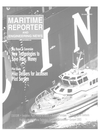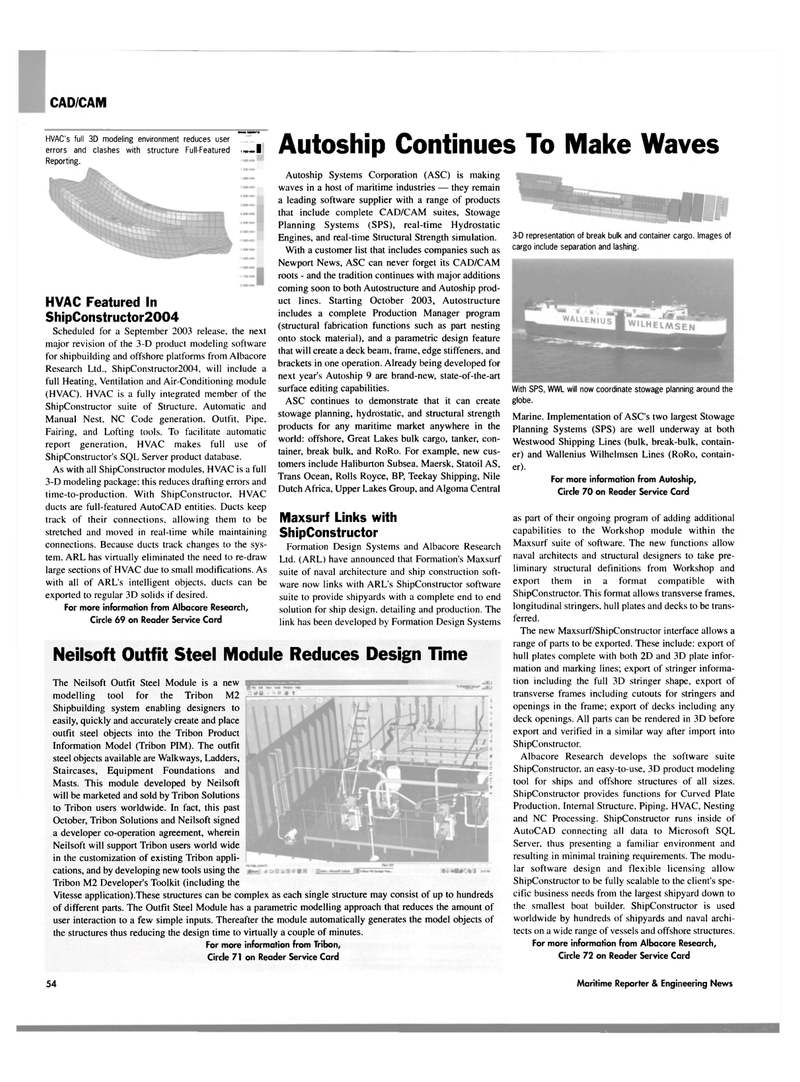
Page 56: of Maritime Reporter Magazine (October 2003)
Read this page in Pdf, Flash or Html5 edition of October 2003 Maritime Reporter Magazine
CAD/CAM
Autoship Continues To Make Waves SSTTSTT HVAC's full 3D modeling environment reduces user errors and clashes with structure Full-Featured I
Reporting.
HVAC Featured In
ShipConstructor2004
Scheduled for a September 2003 release, the next major revision of the 3-D product modeling software for shipbuilding and offshore platforms from Albacore
Research Ltd., ShipConstructor2004, will include a full Heating, Ventilation and Air-Conditioning module (HVAC). HVAC is a fully integrated member of the
ShipConstructor suite of Structure, Automatic and
Manual Nest. NC Code generation. Outfit, Pipe.
Fairing, and Lofting tools. To facilitate automatic report generation, HVAC makes full use of
ShipConstructor's SQL Server product database.
As with all ShipConstructor modules, HVAC is a full 3-D modeling package; this reduces drafting errors and time-to-production. With ShipConstructor, HVAC ducts are full-featured AutoCAD entities. Ducts keep track of their connections, allowing them to be stretched and moved in real-time while maintaining connections. Because ducts track changes to the sys- tem, ARL has virtually eliminated the need to re-draw large sections of HVAC due to small modifications. As with all of ARL's intelligent objects, ducts can be exported to regular 3D solids if desired.
For more information from Albacore Research,
Circle 69 on Reader Service Card
Autoship Systems Corporation (ASC) is making waves in a host of maritime industries — they remain a leading software supplier with a range of products that include complete CAD/CAM suites, Stowage
Planning Systems (SPS), real-time Hydrostatic
Engines, and real-time Structural Strength simulation.
With a customer list that includes companies such as
Newport News, ASC can never forget its CAD/CAM roots - and the tradition continues with major additions coming soon to both Autostructure and Autoship prod- uct lines. Starting October 2003, Autostructure includes a complete Production Manager program (structural fabrication functions such as part nesting onto stock material), and a parametric design feature that will create a deck beam, frame, edge stiffeners, and brackets in one operation. Already being developed for next year's Autoship 9 are brand-new, state-of-the-art surface editing capabilities.
ASC continues to demonstrate that it can create stowage planning, hydrostatic, and structural strength products for any maritime market anywhere in the world: offshore, Great Lakes bulk cargo, tanker, con- tainer, break bulk, and RoRo. For example, new cus- tomers include Haliburton Subsea, Maersk, Statoil AS,
Trans Ocean, Rolls Royce, BP, Teekay Shipping, Nile
Dutch Africa, Upper Lakes Group, and Algoma Central
Maxsurf Links with
ShipConstructor
Formation Design Systems and Albacore Research
Ltd. (ARL) have announced that Formation's Maxsurf suite of naval architecture and ship construction soft- ware now links with ARL's ShipConstructor software suite to provide shipyards with a complete end to end solution for ship design, detailing and production. The link has been developed by Formation Design Systems 3-D representation of break bulk and container cargo. Images of cargo include separation and lashing.
With SPS, WWL will now coordinate stowage planning around the globe.
Marine. Implementation of ASC's two largest Stowage
Planning Systems (SPS) are well underway at both
Westwood Shipping Lines (bulk, break-bulk, contain- er) and Wallenius Wilhelmsen Lines (RoRo, contain- er).
For more information from Autoship,
Circle 70 on Reader Service Card as part of their ongoing program of adding additional capabilities to the Workshop module within the
Maxsurf suite of software. The new functions allow naval architects and structural designers to take pre- liminary structural definitions from Workshop and export them in a format compatible with
ShipConstructor. This format allows transverse frames, longitudinal stringers, hull plates and decks to be trans- ferred.
The new Maxsurf/ShipConstructor interface allows a range of parts to be exported. These include: export of hull plates complete with both 2D and 3D plate infor- mation and marking lines; export of stringer informa- tion including the full 3D stringer shape, export of transverse frames including cutouts for stringers and openings in the frame; export of decks including any deck openings. All parts can be rendered in 3D before export and verified in a similar way after import into
ShipConstructor.
Albacore Research develops the software suite
ShipConstructor, an easy-to-use, 3D product modeling tool for ships and offshore structures of all sizes.
ShipConstructor provides functions for Curved Plate
Production. Internal Structure, Piping, HVAC, Nesting and NC Processing. ShipConstructor runs inside of
AutoCAD connecting all data to Microsoft SQL
Server, thus presenting a familiar environment and resulting in minimal training requirements. The modu- lar software design and flexible licensing allow
ShipConstructor to be fully scalable to the client's spe- cific business needs from the largest shipyard down to the smallest boat builder. ShipConstructor is used worldwide by hundreds of shipyards and naval archi- tects on a wide range of vessels and offshore structures.
For more information from Albacore Research,
Circle 72 on Reader Service Card
Neilsoft Outfit Steel Module Reduces Design Time
The Neilsoft Outfit Steel Module is a new modelling tool for the Tribon M2
Shipbuilding system enabling designers to easily, quickly and accurately create and place outfit steel objects into the Tribon Product
Information Model (Tribon PIM). The outfit steel objects available are Walkways, Ladders,
Staircases, Equipment Foundations and
Masts. This module developed by Neilsoft will be marketed and sold by Tribon Solutions to Tribon users worldwide. In fact, this past
October, Tribon Solutions and Neilsoft signed a developer co-operation agreement, wherein
Neilsoft will support Tribon users world wide in the customization of existing Tribon appli- cations, and by developing new tools using the
Tribon M2 Developer's Toolkit (including the
Vitesse application).These structures can be complex as each single structure may consist of up to hundreds of different parts. The Outfit Steel Module has a parametric modelling approach that reduces the amount of user interaction to a few simple inputs. Thereafter the module automatically generates the model objects of the structures thus reducing the design time to virtually a couple of minutes.
For more information from Tribon,
Circle 71 on Reader Service Card 54 Maritime Reporter & Engineering News

 55
55

 57
57
